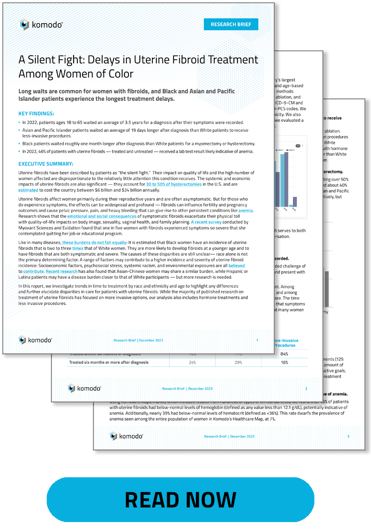A Silent Fight: Delays in Uterine Fibroid Treatment Among Women of Color

Authors: Raquel Freeman, Clinical Product Specialist; Akylah Langley, Customer Success Associate; Tolu Falana, Senior Customer Success Associate; Tabby Khan, Director, Clinical Product; Anna Druet, Senior Science Writer
Long waits are common for women with fibroids, with Black and Asian patients experiencing the longest delays for both less invasive and more invasive treatments.
 The burden of uterine fibroids in the U.S lands as heavily on patients as it does on the medical system: The condition accounts for up to half of all hysterectomies and is estimated to cost between $6 billion and $34 billion annually.
The burden of uterine fibroids in the U.S lands as heavily on patients as it does on the medical system: The condition accounts for up to half of all hysterectomies and is estimated to cost between $6 billion and $34 billion annually.
Beyond common symptoms like pelvic pressure, pain, heavy bleeding, and anemia, the consequences of fibroids on fertility and pregnancy outcomes can be devastating for some patients and can make decisions about treatment much more complicated. Research confirms that the emotional and social impacts of symptomatic fibroids often exacerbate their physical toll. As in many other diseases, Black patients are disproportionately affected, with a significantly higher incidence of symptomatic fibroids and more severe disease overall. Emerging research shows that the same may also be true for Americans of Asian-Chinese descent.
While much research has been conducted on race-based disparities in uterine fibroid treatment, less- and non-invasive treatments have not typically been included in those analyses. Our new research brief looks at several forms of treatment, including hormone medications, less-invasive procedures, and hysterectomy, to examine treatment delays by race, ethnicity, and age.
We found that certain delays were common in all uterine fibroid cases: Patients ages 18 to 65 waited an average of 3.5 years for a diagnosis after their symptoms were recorded. After diagnosis, Asian American patients waited an average of 16 days longer than White patients to receive less-invasive procedures, and both Black and Asian American patients waited roughly one month longer than White patients for more invasive treatments, such as a hysterectomy. Using Komodo’s new MapEnhance™ offering, which includes results from hundreds of types of clinical lab tests, we also found that 46% of patients with uterine fibroids — treated and untreated — received a lab test result in 2022 that was likely indicative of anemia. This rate dwarfs the prevalence of anemia seen among the entire population of women in Komodo’s Healthcare Map™, at 7%.
This analysis adds to the research elucidating race-based disparities in care for patients with uterine fibroids and also adds to our understanding of age-based differences. The trend shown in this analysis highlights the need to address diagnostic delays and race-based gaps in treatment. While racial disparities in the U.S. are deeply rooted, immediate changes in the healthcare system’s approaches can lead to significant improvements in care for these populations. Komodo Health is committed to the application of new software and data technologies to improve patient outcomes and reduce the burden of disease.
Read our research brief here.
Read more of our analyses focused on elucidating race-based gaps in care for  ,
,  , and
, and  .
.
To see more articles like this, follow Komodo Health on X, LinkedIn, or YouTube, and visit Insights on our website.







